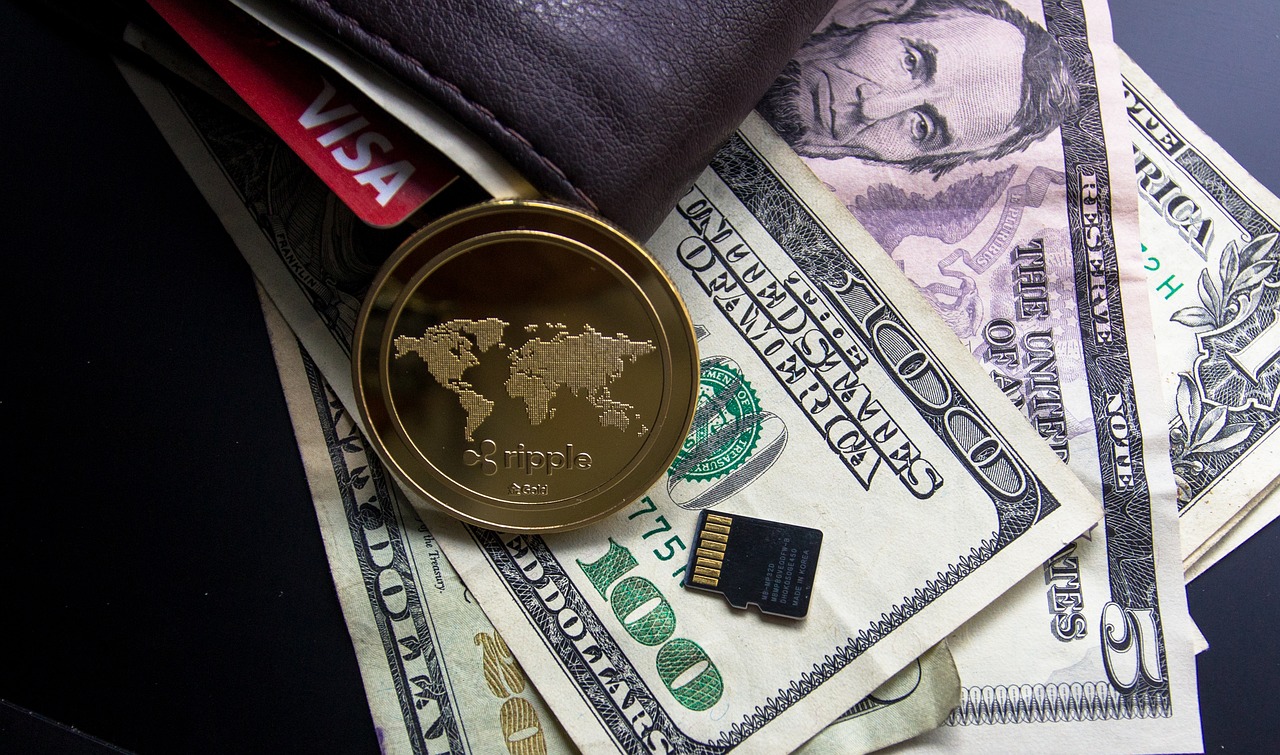The Rise of Decentralized Finance (DeFi) and Its Impact on Wallets
In recent years, the financial landscape has been shaken to its core by the emergence of Decentralized Finance (DeFi). This innovative approach to finance is not just a trend; it's a revolution that is reshaping how we think about money, transactions, and the role of intermediaries. Imagine a world where you can lend, borrow, trade, and earn interest on your assets without ever having to rely on a bank or a financial institution. Sounds liberating, right? Well, that's precisely what DeFi is bringing to the table!
At its core, DeFi leverages the power of blockchain technology to create an ecosystem where users can engage in financial activities directly, without the need for traditional intermediaries. This shift is not only about eliminating middlemen; it's about enhancing accessibility and transparency. Anyone with an internet connection can participate, breaking down the barriers that have historically kept many people out of the financial system. It’s like having a universal key to the vault of financial opportunities!
But what does this mean for digital wallets? Well, the rise of DeFi is fundamentally changing how we use wallets. No longer are they just simple tools for storing cryptocurrencies; they are evolving into sophisticated gateways to a plethora of decentralized applications (dApps) and services. Think of your wallet as a multi-tool for navigating the DeFi landscape. With the right wallet, you can seamlessly interact with decentralized exchanges, lending platforms, and yield farming opportunities—all from one place!
As we dive deeper into the world of DeFi, it’s crucial to understand the implications this has on digital wallets. With the increasing complexity of DeFi applications, users are demanding wallets that are not only secure but also user-friendly. The need for advanced security measures is paramount, as the stakes are higher than ever. Users must be educated about safeguarding their private keys and understanding the potential vulnerabilities that come with decentralized platforms. It’s like walking a tightrope; one misstep can lead to significant financial losses.
In essence, the rise of DeFi is not just about new technologies; it’s about empowering individuals. It’s about taking control of one’s financial destiny and participating in a system that prioritizes user autonomy. As we explore the various facets of DeFi and its impact on wallets, we will uncover the challenges and opportunities that lie ahead, paving the way for a more inclusive financial future.
- What is Decentralized Finance (DeFi)? DeFi refers to financial services built on blockchain technology that operate without intermediaries, allowing for peer-to-peer transactions.
- How does DeFi impact digital wallets? DeFi has transformed digital wallets into essential tools for accessing decentralized applications, requiring improved security and user-friendly interfaces.
- What are the security concerns associated with DeFi wallets? Users must be cautious about safeguarding private keys and understanding risks related to decentralized platforms.
- What types of wallets are available for DeFi? Users can choose from hot wallets, cold wallets, and hardware wallets, each offering different levels of security and functionality.
- What are the future trends in DeFi wallet development? Future wallets are expected to focus on enhanced security features, cross-chain compatibility, and improved user experiences.

Understanding Decentralized Finance (DeFi)
This article explores the emergence of decentralized finance, its influence on digital wallets, and the broader implications for financial systems and user autonomy in the cryptocurrency landscape.
Decentralized Finance, commonly referred to as DeFi, is revolutionizing the way we think about money and financial systems. Imagine a world where you can lend, borrow, trade, and earn interest on your assets without ever stepping foot in a bank. That's the magic of DeFi! This movement leverages blockchain technology to eliminate the need for intermediaries, such as banks or financial institutions, allowing users to engage directly with one another.
At its core, DeFi is about accessibility and transparency. Traditional financial systems often impose barriers that can exclude large segments of the population. In contrast, DeFi platforms are available to anyone with an internet connection. This democratization of finance means that even those in remote areas can participate in global markets. But how does it all work? Let's break it down.
DeFi operates on smart contracts, which are self-executing contracts with the terms of the agreement directly written into code. These smart contracts run on blockchain networks, mainly Ethereum, and they automate processes that would typically require human intervention. This automation not only speeds up transactions but also reduces the possibility of human error. For instance, when you lend your cryptocurrency through a DeFi platform, a smart contract ensures that the terms are met without needing a bank to oversee the transaction.
Here are some key features that make DeFi so appealing:
- Interoperability: Many DeFi applications can work together, allowing users to move their assets seamlessly across different platforms.
- Permissionless Access: Anyone can access DeFi services without needing approval from a centralized authority.
- Transparency: All transactions are recorded on the blockchain, providing a public ledger that anyone can inspect.
- Yield Farming: Users can earn rewards by providing liquidity to various protocols, often yielding high returns.
As DeFi continues to grow, it's also important to acknowledge the potential risks involved. While the idea of a decentralized financial system is exciting, it comes with challenges like security vulnerabilities, market volatility, and the complexity of use for newcomers. Users must educate themselves about the platforms they choose to engage with, as the decentralized nature of DeFi means that there is often no customer support to turn to for help.
In conclusion, DeFi represents a significant shift in the financial landscape, offering unprecedented opportunities for financial autonomy and innovation. As more people become aware of the benefits and functionalities of DeFi, we can expect to see a surge in its adoption, further challenging the traditional financial systems that have long dominated our economic lives.
The rise of DeFi has transformed how users interact with digital wallets, necessitating advanced security measures and user-friendly interfaces to accommodate a growing array of decentralized applications and services.
As DeFi gains popularity, security concerns regarding wallets have intensified, highlighting the importance of safeguarding private keys and ensuring users are educated on potential vulnerabilities and risks associated with decentralized platforms.
Various wallet types cater to DeFi users, including hot wallets, cold wallets, and hardware wallets, each offering distinct features, security levels, and functionalities tailored to different user needs and risk appetites.
Seamless integration of wallets with DeFi protocols is essential for enhancing user experience, allowing for easy access to decentralized exchanges, lending platforms, and yield farming opportunities directly from users' wallets.
User experience plays a pivotal role in the adoption of DeFi wallets, with intuitive interfaces and streamlined processes encouraging more users to engage with decentralized finance and its myriad offerings.
Smart contracts underpin DeFi applications, automating transactions and processes without the need for intermediaries, thus enhancing efficiency and trust while minimizing the potential for human error in financial dealings.
Despite their advantages, DeFi wallets face challenges such as regulatory scrutiny, scalability issues, and user education, which must be addressed to ensure long-term viability and widespread adoption in the financial ecosystem.
As DeFi continues to evolve, future wallet developments will likely focus on enhanced security features, cross-chain compatibility, and improved user interfaces, ultimately aiming to create a more inclusive and accessible financial landscape.
Q1: What is DeFi?
A1: DeFi stands for Decentralized Finance, which refers to a financial system built on blockchain technology that allows users to engage in financial transactions without intermediaries.
Q2: How do I get started with DeFi?
A2: To start with DeFi, you typically need a digital wallet that supports cryptocurrency, some funds to invest, and an understanding of the platforms you wish to use.
Q3: Are DeFi platforms safe?
A3: While DeFi platforms offer numerous benefits, they also come with risks, including security vulnerabilities and market volatility. It's crucial to conduct thorough research before engaging.
Q4: Can I lose my money in DeFi?
A4: Yes, like any investment, there are risks involved in DeFi. Users can lose their funds due to market fluctuations, smart contract bugs, or security breaches.
Q5: What types of wallets are best for DeFi?
A5: The best wallet for DeFi depends on your needs. Hot wallets are more user-friendly but less secure, while cold wallets offer higher security but may be less convenient for frequent transactions.

How DeFi is Changing Wallet Usage
Decentralized Finance, or DeFi, is not just a buzzword; it’s a revolution that’s reshaping the landscape of how we think about finance. With the rise of DeFi, the way users interact with their digital wallets is undergoing a significant transformation. Gone are the days when wallets were merely tools for holding cryptocurrencies. Now, they are becoming gateways to a plethora of decentralized applications (dApps) and services. This shift is not just about convenience; it’s about empowerment. Users are gaining unprecedented control over their financial assets, but this comes with its own set of challenges.
As DeFi platforms proliferate, wallets are evolving to meet the demands of a more complex ecosystem. Users are now looking for wallets that provide not only security but also seamless access to various DeFi services, such as lending, borrowing, and trading. This has led to the development of wallets that integrate directly with DeFi protocols, allowing users to interact with decentralized exchanges and yield farming opportunities with just a few clicks. Imagine having the power to manage your investments, trade assets, and earn interest all from one interface. This is the future that DeFi wallets are striving to create.
However, with great power comes great responsibility. The rise of DeFi has heightened the need for advanced security measures. Users must now be more vigilant than ever about safeguarding their private keys and understanding the potential vulnerabilities of the platforms they use. It’s a bit like being given the keys to a high-tech vault; while you have the freedom to access your assets anytime, you must also be aware of the risks associated with leaving it unguarded. This has prompted many wallet providers to implement enhanced security features, such as multi-signature authentication and biometric verification, to protect users’ funds.
Moreover, the user experience in DeFi wallets has become a critical focus. Developers are working tirelessly to create intuitive interfaces that simplify the complexities of DeFi. Imagine walking into a high-tech bank where everything is automated, yet the interface is so user-friendly that even a novice can navigate it with ease. This is what wallet developers aim to achieve. The goal is to lower the barrier to entry for users who may be intimidated by the technical jargon often associated with cryptocurrency and DeFi.
In summary, the rise of DeFi is fundamentally altering how users engage with their wallets. As wallets become more integrated with DeFi platforms, the emphasis on security, user experience, and accessibility is paramount. With each advancement, users are not just passive participants; they are becoming active players in a decentralized financial ecosystem that promises to redefine the very nature of finance.
- What is DeFi? DeFi stands for Decentralized Finance, which refers to a financial system built on blockchain technology that allows users to conduct transactions without intermediaries.
- How do DeFi wallets work? DeFi wallets facilitate access to decentralized applications and services, enabling users to manage their assets, trade, and earn interest directly from their wallets.
- Are DeFi wallets secure? While many DeFi wallets implement advanced security features, users must remain vigilant about safeguarding their private keys and understanding the risks involved.
- What types of wallets are available for DeFi? Common types of wallets include hot wallets, cold wallets, and hardware wallets, each offering different levels of security and functionality.

Security Concerns in DeFi Wallets
As the popularity of Decentralized Finance (DeFi) soars, the spotlight on security concerns regarding digital wallets has intensified. Imagine you have a treasure chest filled with gold coins, but the chest is left unlocked in a bustling marketplace. This scenario mirrors the current state of many DeFi wallets, where users often overlook the importance of safeguarding their assets. With no central authority to turn to in case of a breach, the onus lies entirely on the users to protect their investments.
One of the primary security issues arises from the management of private keys. These keys are akin to the keys to your home; losing them can lead to dire consequences. If someone gains access to your private key, they can drain your wallet without any recourse for recovery. It’s crucial for users to understand that the decentralized nature of DeFi means that there are no customer support teams to help retrieve lost assets. Therefore, implementing strong security practices is not just recommended; it’s essential.
Moreover, DeFi wallets are often targeted by hackers who exploit vulnerabilities in the underlying smart contracts or the wallet's interface. Users must remain vigilant and educate themselves about the risks associated with decentralized platforms. Here are some common vulnerabilities:
- Phishing Attacks: Users may unknowingly enter their private keys or recovery phrases on fake websites.
- Smart Contract Bugs: Flaws in the code can be exploited, leading to significant financial losses.
- Malware: Malicious software can compromise wallet security and steal sensitive information.
To mitigate these risks, users should consider employing various security measures. Utilizing hardware wallets can add a layer of protection, as these devices store private keys offline, away from potential online threats. Additionally, users should regularly update their software and be cautious about the applications they interact with. It’s also wise to engage in community discussions and follow reputable sources to stay informed about the latest security practices.
In conclusion, while DeFi wallets offer exciting opportunities for financial autonomy and innovation, they also come with significant security responsibilities. Users must be proactive in safeguarding their assets, understanding that the freedom provided by DeFi comes with risks that require diligence and education to navigate successfully.
- What is a DeFi wallet?
A DeFi wallet is a digital wallet that allows users to interact with decentralized finance applications, enabling them to store, send, and receive cryptocurrencies while maintaining control over their private keys.
- How can I secure my DeFi wallet?
To secure your DeFi wallet, use hardware wallets, enable two-factor authentication, regularly update your software, and be cautious of phishing attempts.
- What should I do if I lose my private key?
If you lose your private key, unfortunately, there is no way to recover your funds. It's essential to keep backups and use secure methods to store your keys.

Types of Wallets for DeFi
When it comes to decentralized finance (DeFi), selecting the right type of wallet is crucial for both security and functionality. Just like choosing the right tool for a job, the type of wallet you use can significantly impact your experience in the DeFi ecosystem. There are three primary types of wallets that cater to DeFi users: hot wallets, cold wallets, and hardware wallets. Each of these wallet types has its unique features, security levels, and functionalities, making them suitable for different user needs and risk appetites.
Hot wallets are the most commonly used wallets in the DeFi space. They are connected to the internet, which makes them incredibly convenient for quick transactions and easy access to decentralized applications (dApps). However, this connectivity also makes them more vulnerable to hacks and cyberattacks. Users should be cautious and implement additional security measures, such as two-factor authentication (2FA), to protect their assets.
On the other hand, cold wallets are offline storage solutions that provide a higher level of security. These wallets are not connected to the internet, making them less susceptible to cyber threats. Cold wallets are ideal for long-term storage of cryptocurrencies and DeFi tokens, as they prioritize security over convenience. Users who hold significant amounts of digital assets often prefer cold wallets for this reason. However, accessing funds in a cold wallet can be less convenient, as it requires a bit more effort to transfer assets back online.
Lastly, we have hardware wallets, which are a type of cold wallet but come with their own set of unique features. These physical devices store your private keys securely and can interact with various DeFi platforms. Hardware wallets are often seen as the gold standard for security, as they provide a robust defense against online threats. Users can easily plug their hardware wallets into a computer or mobile device to access their funds, making them a popular choice for serious investors.
To better understand the differences between these wallet types, here's a quick comparison:
| Wallet Type | Security Level | Convenience | Best For |
|---|---|---|---|
| Hot Wallet | Low to Medium | High | Frequent traders |
| Cold Wallet | High | Low | Long-term holders |
| Hardware Wallet | Very High | Medium | Serious investors |
In summary, understanding the types of wallets available for DeFi is essential for navigating this exciting yet complex landscape. Whether you prioritize convenience, security, or a balance of both, there is a wallet type that fits your needs. As you dive deeper into the world of decentralized finance, consider your own risk tolerance and usage patterns to make the best choice for your digital assets.
- What is the safest type of wallet for DeFi? Cold wallets and hardware wallets are generally considered the safest options due to their offline storage capabilities.
- Can I use multiple wallets for DeFi? Yes! Many users choose to use a combination of wallet types to balance convenience and security.
- Are hot wallets suitable for large amounts of cryptocurrency? While hot wallets offer convenience, they are not recommended for storing large amounts of cryptocurrency due to security risks.
- How do I transfer funds between wallets? Transfers can typically be made by sending funds from one wallet address to another, but ensure you follow the correct procedures for each wallet type.

Wallet Integration with DeFi Protocols
The integration of wallets with Decentralized Finance (DeFi) protocols is a game changer in the financial landscape. Imagine your wallet not just as a digital safe for your cryptocurrencies but as a gateway to a world of financial opportunities. This seamless connection allows users to engage directly with decentralized applications (dApps), making transactions smoother and more efficient than ever before. With the rise of DeFi, users can access a plethora of services—like decentralized exchanges (DEXs), lending platforms, and yield farming opportunities—right from their wallets. This level of access empowers users, giving them control over their financial activities without relying on traditional intermediaries.
One of the most significant advantages of wallet integration with DeFi protocols is the ability to manage multiple assets and services from a single interface. Users can easily swap tokens, lend assets, or stake cryptocurrencies without jumping through hoops. This not only saves time but also enhances the overall user experience. For instance, imagine wanting to lend some of your assets for interest while simultaneously trading another token on a DEX. With integrated wallets, you can execute these actions in just a few clicks, making the process feel almost effortless.
However, this integration isn't without its challenges. Developers must ensure that the wallets can handle the complexities of various DeFi protocols. Each protocol may have its own set of rules, token standards, and transaction processes, which can lead to confusion for users. Therefore, creating a user-friendly interface that abstracts these complexities is essential. Wallet developers are increasingly focusing on enhancing the user experience by providing clear instructions and intuitive designs, allowing even the most novice users to navigate the DeFi space with confidence.
Moreover, security remains a top concern. As wallets become the primary access point to DeFi applications, they must implement robust security measures to protect users' funds. This includes safeguarding private keys, utilizing multi-signature wallets, and employing two-factor authentication (2FA). Users must remain vigilant and educated about potential risks, ensuring they choose wallets that prioritize security while offering seamless integration with DeFi protocols.
In summary, wallet integration with DeFi protocols is not just a technological advancement; it represents a shift in how we interact with finance. As this integration evolves, we can expect wallets to become even more sophisticated, offering enhanced features that cater to the diverse needs of users. The future of finance is here, and it's decentralized, accessible, and at your fingertips.
- What is a DeFi wallet? A DeFi wallet is a digital wallet that allows users to interact with decentralized finance applications, facilitating transactions without intermediaries.
- How do I choose a wallet for DeFi? Look for wallets that offer strong security features, user-friendly interfaces, and seamless integration with various DeFi protocols.
- Are DeFi wallets safe? While DeFi wallets can be secure, users must take precautions, such as safeguarding private keys and using wallets with robust security measures.
- Can I use a traditional wallet for DeFi? Some traditional wallets may support DeFi applications, but specialized DeFi wallets are often better optimized for these services.

User Experience in DeFi Wallets
The user experience (UX) in Decentralized Finance (DeFi) wallets is crucial for the adoption of this revolutionary financial technology. Imagine stepping into a vast digital marketplace where you can trade, lend, or invest without the constraints of traditional banking systems. However, if the tools to navigate this marketplace are clunky or confusing, you might just turn back around. This is why a seamless, intuitive user interface is not just a luxury—it's a necessity. A well-designed DeFi wallet can make the difference between a user feeling empowered or overwhelmed.
One of the most compelling aspects of DeFi wallets is their ability to simplify complex transactions. Users should feel like they are in control, not like they are deciphering a cryptic code. To achieve this, wallet developers are focusing on clean designs, easy navigation, and clear instructions. For instance, a wallet that allows users to swap tokens with just a few clicks can significantly enhance the overall experience. If you think about it, it's akin to having a user-friendly app on your smartphone that lets you order food in seconds, versus a complicated website that makes you feel like you need a degree in computer science just to place an order.
Moreover, the integration of various DeFi services directly within wallets is a game-changer. Users can access decentralized exchanges, lending platforms, and yield farming opportunities without needing to juggle multiple applications. This level of integration not only saves time but also reduces the cognitive load on users. Imagine being able to manage your entire financial portfolio from a single dashboard—this is the future that DeFi wallets are striving to create.
However, it’s essential to recognize that not all users are tech-savvy. Many individuals are still grappling with the basics of cryptocurrency, and the complexity of DeFi can be intimidating. Therefore, educational resources and tutorials embedded within wallets can significantly improve user experience. For example, a wallet that offers step-by-step guides or video tutorials can help demystify the process of using DeFi services, making them more accessible to a broader audience.
In addition, security features play a pivotal role in the user experience. Users need to feel safe when managing their assets. Wallets that incorporate biometric authentication, two-factor authentication, and easy recovery options for lost keys can enhance trust and confidence. After all, if users feel secure, they are more likely to engage actively with DeFi services. A wallet that prioritizes security while maintaining usability is akin to a fortress with a welcoming entrance—inviting yet protective.
As we look to the future, it's clear that the user experience in DeFi wallets will continue to evolve. Developers are likely to focus on cross-chain compatibility, enabling users to interact with multiple blockchain networks seamlessly. This could open up a world of possibilities, allowing for even greater flexibility and choice. In this rapidly changing landscape, the wallets that prioritize user experience will undoubtedly lead the charge, paving the way for a more inclusive and accessible financial ecosystem.
- What is a DeFi wallet? A DeFi wallet is a digital wallet that allows users to interact with decentralized finance applications, enabling them to trade, lend, and invest without intermediaries.
- How do I choose the right DeFi wallet? Consider factors such as security features, user interface, integration with DeFi protocols, and whether it supports the tokens you wish to use.
- Are DeFi wallets safe? While DeFi wallets can offer enhanced security features, users must also be diligent in safeguarding their private keys and understanding potential risks.
- Can I use a DeFi wallet for traditional cryptocurrencies? Yes, many DeFi wallets support popular cryptocurrencies like Bitcoin and Ethereum, allowing for a versatile experience.

The Role of Smart Contracts in DeFi
Smart contracts are the backbone of the Decentralized Finance (DeFi) ecosystem, acting as self-executing contracts with the terms of the agreement directly written into code. Imagine a vending machine: you put in your money, select your item, and the machine automatically dispenses it without needing a cashier. That's how smart contracts work—they automate transactions and processes, eliminating the need for intermediaries and enhancing efficiency.
By leveraging blockchain technology, smart contracts ensure that all transactions are transparent, secure, and immutable. This means that once a smart contract is deployed, it cannot be altered, which significantly reduces the risk of fraud. Users can trust that the terms of the contract will be executed exactly as agreed upon, without the worry of manipulation by a third party. This level of trust is revolutionary in the world of finance, where traditional systems often rely on intermediaries to enforce agreements.
Moreover, smart contracts facilitate a variety of DeFi applications, including:
- Decentralized Exchanges (DEXs): These platforms allow users to trade cryptocurrencies directly with one another, using smart contracts to manage trades automatically.
- Lending and Borrowing Platforms: Smart contracts enable users to lend their assets and earn interest, or borrow assets without the need for traditional banks.
- Yield Farming: Users can lock their assets in smart contracts to earn rewards, often in the form of additional tokens.
However, while the benefits of smart contracts are significant, they are not without challenges. One major concern is the potential for bugs or vulnerabilities in the code, which could be exploited by malicious actors. Just like a poorly coded software application can lead to security breaches, a flawed smart contract can result in significant financial losses. Therefore, it's crucial for developers to rigorously test and audit smart contracts before deployment.
Additionally, the complexity of smart contracts can be a barrier for many users. Understanding how these contracts function, and the implications of engaging with them, requires a certain level of technical knowledge. As the DeFi space evolves, user education will play a critical role in ensuring that individuals can navigate these systems safely and effectively.
In conclusion, smart contracts are a fundamental component of the DeFi landscape, driving innovation and enabling a new era of financial autonomy. As more users begin to understand and trust these automated agreements, we can expect to see a surge in DeFi adoption, reshaping the financial services industry as we know it.
What is a smart contract?
A smart contract is a self-executing contract with the terms of the agreement directly written into code, allowing for automated transactions without intermediaries.
How do smart contracts enhance security in DeFi?
Smart contracts are deployed on blockchain technology, making them transparent, immutable, and secure from fraud and manipulation.
What are the risks associated with smart contracts?
The primary risks include bugs or vulnerabilities in the code that can be exploited, leading to financial losses.
Can anyone create a smart contract?
Yes, anyone with programming knowledge can create a smart contract, but it requires careful coding and testing to ensure its security and functionality.

Challenges Facing DeFi Wallets
The rapid rise of Decentralized Finance (DeFi) has brought along a wave of excitement and innovation, but it hasn't been without its fair share of challenges, especially when it comes to wallets. As more users flock to these platforms, the intricacies of managing their digital assets become increasingly complex. One of the primary issues is regulatory scrutiny. Governments around the world are still grappling with how to regulate cryptocurrencies and DeFi applications. This uncertainty can create hesitancy among potential users who worry about the legality and safety of their investments.
Moreover, there are significant scalability issues that DeFi wallets face. As the number of transactions increases, the underlying blockchain networks often experience congestion, leading to slower transaction times and higher fees. Imagine trying to catch a bus during rush hour; the more people there are, the harder it is to get on. This scenario is similar to what happens when too many users attempt to access DeFi services simultaneously. It can be frustrating, and it discourages users from utilizing these platforms to their full potential.
Another pressing concern is user education. Many users are still unfamiliar with how DeFi operates, which can lead to mistakes that might result in financial loss. For instance, users may not understand the importance of safeguarding their private keys or how to navigate the complexities of smart contracts. It's crucial for wallet providers and DeFi platforms to invest in educational resources, ensuring that users are well-informed about the risks and best practices associated with decentralized finance.
To shed light on these challenges, let's take a look at a table summarizing the primary obstacles facing DeFi wallets:
| Challenge | Description |
|---|---|
| Regulatory Scrutiny | Uncertainty regarding government regulations can deter users from engaging with DeFi wallets. |
| Scalability Issues | High transaction volumes can lead to network congestion, resulting in slower transactions and increased fees. |
| User Education | Lack of understanding about DeFi can lead to mistakes, emphasizing the need for educational resources. |
In conclusion, while DeFi wallets offer a revolutionary way to manage finances, they are not without challenges. Addressing regulatory concerns, improving scalability, and enhancing user education will be crucial for the long-term success and adoption of these wallets. As the landscape continues to evolve, stakeholders must collaborate to create solutions that not only enhance the user experience but also foster a safer and more inclusive financial ecosystem.
- What are DeFi wallets? DeFi wallets are digital wallets that allow users to interact with decentralized finance applications, enabling them to trade, lend, and borrow cryptocurrencies without intermediaries.
- Are DeFi wallets secure? While DeFi wallets offer various security features, users must take precautions, such as safeguarding their private keys and being aware of potential vulnerabilities.
- How can I educate myself about DeFi? There are numerous resources available online, including tutorials, articles, and community forums, to help you understand the fundamentals of decentralized finance.
- What should I consider when choosing a DeFi wallet? Consider factors like security features, user interface, compatibility with different DeFi protocols, and community reviews before selecting a wallet.

Future Trends in DeFi Wallet Development
The landscape of Decentralized Finance (DeFi) is continuously evolving, and with it, the development of digital wallets is set to undergo significant transformations. As we look ahead, several key trends are emerging that are likely to shape the future of DeFi wallets. One of the most prominent trends is the focus on enhanced security features. With the increasing number of hacks and breaches in the DeFi space, wallet developers are prioritizing robust security measures, such as multi-signature authentication and biometric verification, to protect users' assets. These features not only bolster security but also build trust among users who may be hesitant to engage with DeFi due to security concerns.
Another critical trend is the push for cross-chain compatibility. Currently, many DeFi protocols operate on specific blockchain networks, which can create silos and limit user access to a broader range of services. Future wallet developments are likely to address this issue by integrating cross-chain functionality, allowing users to seamlessly interact with multiple blockchains. This interoperability will not only enhance user experience but also promote liquidity across different platforms, making DeFi more accessible and efficient.
Moreover, the user interface (UI) and user experience (UX) of DeFi wallets are expected to improve dramatically. As more individuals enter the DeFi space, the demand for intuitive and user-friendly interfaces will grow. Developers will need to focus on simplifying complex processes, providing clear guidance, and offering educational resources within wallets. This shift will help demystify DeFi for newcomers, encouraging wider adoption and participation.
Additionally, the integration of decentralized identity solutions is on the horizon. As privacy concerns continue to rise, users will seek wallets that allow them to maintain control over their personal information while still complying with regulatory requirements. Decentralized identity systems can provide a secure way for users to authenticate themselves without revealing sensitive data, thus enhancing both privacy and security.
Lastly, we can expect to see a rise in social trading features within DeFi wallets. Just like traditional finance, where investors often seek advice from peers or follow successful traders, DeFi wallets might incorporate social elements that allow users to share strategies, insights, and even copy trades from experienced investors. This could foster a sense of community and collaboration, making DeFi more approachable for everyone.
In summary, the future of DeFi wallet development is bright, with trends pointing towards enhanced security, cross-chain compatibility, improved user interfaces, decentralized identity solutions, and social trading features. As these innovations take shape, they will undoubtedly contribute to a more inclusive, secure, and user-friendly DeFi ecosystem.
- What are DeFi wallets? DeFi wallets are digital wallets designed for interacting with decentralized finance applications, allowing users to manage their cryptocurrencies and engage in various financial activities without intermediaries.
- How do DeFi wallets ensure security? DeFi wallets implement various security measures, including private key management, multi-signature authentication, and biometric verification, to protect user assets from unauthorized access.
- What is cross-chain compatibility? Cross-chain compatibility refers to the ability of a wallet or application to interact with multiple blockchain networks, enabling users to access a wider range of DeFi services.
- Why is user experience important in DeFi wallets? A positive user experience encourages more people to engage with DeFi, making it essential for wallet developers to create intuitive interfaces and streamline processes.
Frequently Asked Questions
- What is Decentralized Finance (DeFi)?
Decentralized Finance, or DeFi, refers to a financial system built on blockchain technology that eliminates intermediaries like banks. It enables users to conduct transactions directly with each other, enhancing accessibility and transparency in financial dealings.
- How does DeFi affect digital wallets?
DeFi has transformed digital wallets by requiring more advanced security features and user-friendly interfaces. As users engage with various decentralized applications, wallets need to support these functionalities seamlessly, allowing for easy access to DeFi services.
- What security concerns should I be aware of with DeFi wallets?
Security is paramount in DeFi wallets. Users must safeguard their private keys and be aware of potential vulnerabilities. Educating oneself about phishing attacks, smart contract risks, and other security threats is crucial to protect assets.
- What types of wallets are available for DeFi users?
There are several types of wallets for DeFi, including hot wallets (connected to the internet), cold wallets (offline storage), and hardware wallets (physical devices). Each type offers different security levels and functionalities to cater to varying user needs and risk appetites.
- How do wallets integrate with DeFi protocols?
Wallet integration with DeFi protocols is essential for a smooth user experience. This integration allows users to access decentralized exchanges, lending platforms, and yield farming opportunities directly from their wallets, streamlining the entire process.
- Why is user experience important in DeFi wallets?
User experience is crucial for the adoption of DeFi wallets. A well-designed interface and streamlined processes encourage more users to engage with decentralized finance, making it easier for them to navigate through various offerings and services.
- What role do smart contracts play in DeFi?
Smart contracts are the backbone of DeFi applications. They automate transactions and processes without needing intermediaries, enhancing efficiency and trust while minimizing the risk of human error in financial dealings.
- What challenges do DeFi wallets face?
DeFi wallets encounter several challenges, including regulatory scrutiny, scalability issues, and the need for user education. Addressing these challenges is vital for the long-term viability and widespread adoption of DeFi in the financial ecosystem.
- What future trends can we expect in DeFi wallet development?
The future of DeFi wallets will likely focus on enhanced security features, cross-chain compatibility, and improved user interfaces. These advancements aim to create a more inclusive and accessible financial landscape for all users.



















